Who Controls the User Experience? AMD’s Carrizo Thoroughly Tested
by Ian Cutress on February 4, 2016 8:00 AM ESTBenchmark Results: Professional and OpenCL
Here are our results from our Professional and OpenCL tests. A reminder of our systems, including their graphics:
| System Overview | ||||
| µArch | APU + GPU | Memory | Channel | |
| HP Elitebook 745 G2 | Kaveri | A10 PRO-7350B (19W) R6, 384 SPs, 533 MHz |
8 GB | Dual |
| HP Elitebook 745 G3 | Carrizo | PRO A12-8800B (15W) R7, 512 SPs, 800 MHz |
4 GB | Single |
| Toshiba Satellite E45DW-C4210 |
Carrizo | FX-8800P (15W) R7, 512 SPs, 800 MHz |
8 GB | Single |
| HP Pavilion 17z-g100 |
Carrizo | A10-8700P (15W) R6, 384 SPs, 800 MHz |
8 GB | Single |
| Lenovo Y700 | Carrizo | FX-8800P (15W) R7, 512 SPs, 800 MHz R9 385MX, 512 SPs, 900-100 MHz |
16 GB | Single |
PCMark 08
PCMark08, developed by Futuremark, is a simple press play and run benchmarking tool designed to probe how well systems cope with a variety of standard tasks that a professional user might encounter. This includes video conferencing with multiple streams, image/file manipulation, video processing, 3D modelling and other tools. In this case we take the three main benchmark sets, Creative, Home and Work, and run them in OpenCL mode which aims to take advantage of OpenCL accelerated hardware. For fun we also put in the PCMark08 Storage workset.
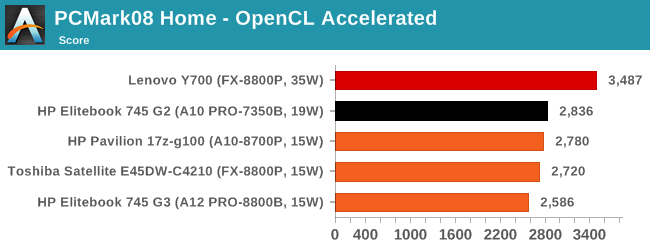
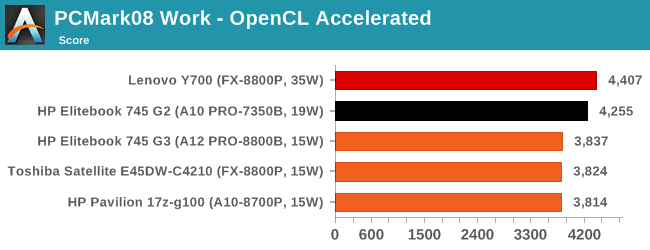
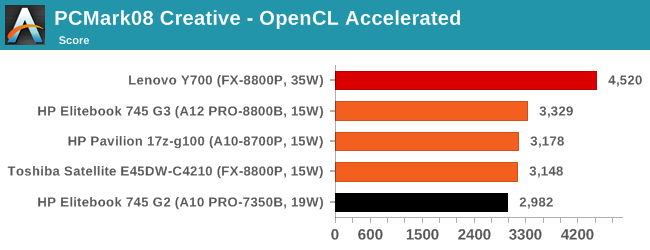
Both of the Home and Work tests show something starteling in the Kaveri system beating all the 15W Carrizo parts. This comes back to what we saw on WebXPRT on the last page – these workloads are very bursty in nature, requiring the system to wake up, run a small amount of work, and go back to sleep. It would seem that this requires a lot more effort from the Carrizo platforms than the Kaveri ones (perhaps by nature of the lower idle power draw starting point on Carrizo) which impacts time critical performance metrics.
If we take the CPU frequencies of the two Elitebook systems, starting with the 745 G2 (Kaveri)
Here the standard frequency tends to be in the 3300 MHz region, moving down to lower frequencies when more threads are needed. But for the 745 G3 (Carrizo):
Here the CPU frequency is obviously mostly at the 2500 MHz mark, sometimes bursting up to 3400 MHz (It’s actually more of a 2:1 split in favor of 2500 MHz).
You might argue that the temperature of the design might be to blame. Both Elitebooks are in the same chassis, so let us see:
(take note of the scales)
Here it shows the G2 wanting to stay below 60C, whereas the G3 is happy to go almost to 80C, albeit with an average temperature which is nearer 50C. This means that the G2 can arguably keep the higher frequencies for longer.
Just to weigh in on the other 15W Carrizo designs in the Toshiba Satellite and HP Pavilion:
In both cases, similar to the G3, the main frequency for the test is actually the lower 2500/2300 frequency, with the system moving up to the higher frequency state around a third of the time, rather than staying at the higher state and moving back down. This is what is causing the Kaveri system to win out in these sorts of workloads (though likely at a power penalty).
On the storage front, having a mechanical drive is a killer here.

Agisoft Photoscan
Photoscan is professional software that takes a series of 2D images (as little as 50, usually 250+) and 'performs calculations' to determine where the pictures were taken and if it can create a 3D model and textures of what the images are of. This model can then be exported to other software for touch-ups or implementation in physics engines/games or, as the reader that directed me to it, national archiving. The tool has four phases, one of which can be OpenCL accelerated, while the other three are a mix of single thread and variable thread workloads. We ran the tool in CPU only and OpenCL modes.
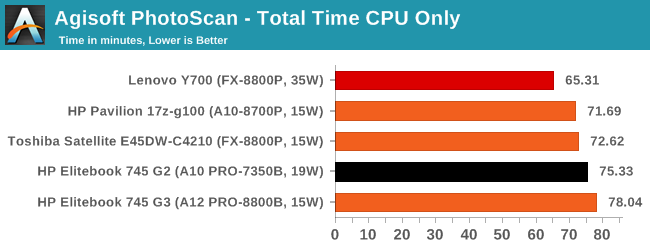
When pure CPU performance matters, having the higher thermal headroom matters most. But moving it to the OpenCL mode shows that those extra TDP points can matter a lot on load balancing:
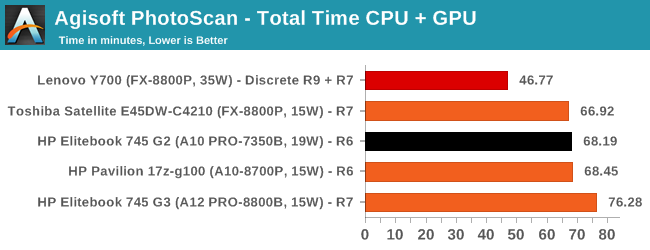
There are two things to note here. One, something seems to have gone very wrong with the G3, and I’m sure those numbers are erroneous and need to be re-run or the 4GB of memory is actually a hindrance here. The second is that the combination R7/R9 graphics in the Lenovo, despite not being in Crossfire, can both be used in OpenCL mode. This pushes a speed up of almost 30%.
Linux Bench
Linux Bench is a collection of Linux based benchmarks compiled together by ServeTheHome. The idea for this is to have some non-windows based tools that are easy enough to run with a USB key, an internet connection and three lines of code in a terminal. The tests in Linux Bench include standard synthetic compute, compression, matrix manipulation, database tools and key-value storage.
Unfortunately Linux Bench refused to run on any of the HP systems for relatively unknown reasons – the fact that it was all the HP models perhaps means that there is something firmware related which is causing the LiveCD to not boot properly. Nonetheless, the results are here for completeness.
| Linux Bench | ||
| Toshiba Satellite E45DW-C4210 (15W) |
Lenovo Y700 (35W) |
|
| C-Ray Hard Test / seconds | 365 | 267 |
| 7-Zip Compression MIPS | 5718 | 6110 |
| 7-Zip Decompression MIPS | 7320 | 9733 |
| NAMD (steps per time) | 1.72 | 2.46 |
| NPB MOPS (per sec per thread) | 365 | 321 |
| OpenSSL Sign | 220 | 296 |
| OpenSSL Verify | 13518 | 19465 |
| Redis 1 | 13210 | 12034 |
| Redis 10 | 41494 | 38760 |
| Redis 100 | 33445 | 31949 |






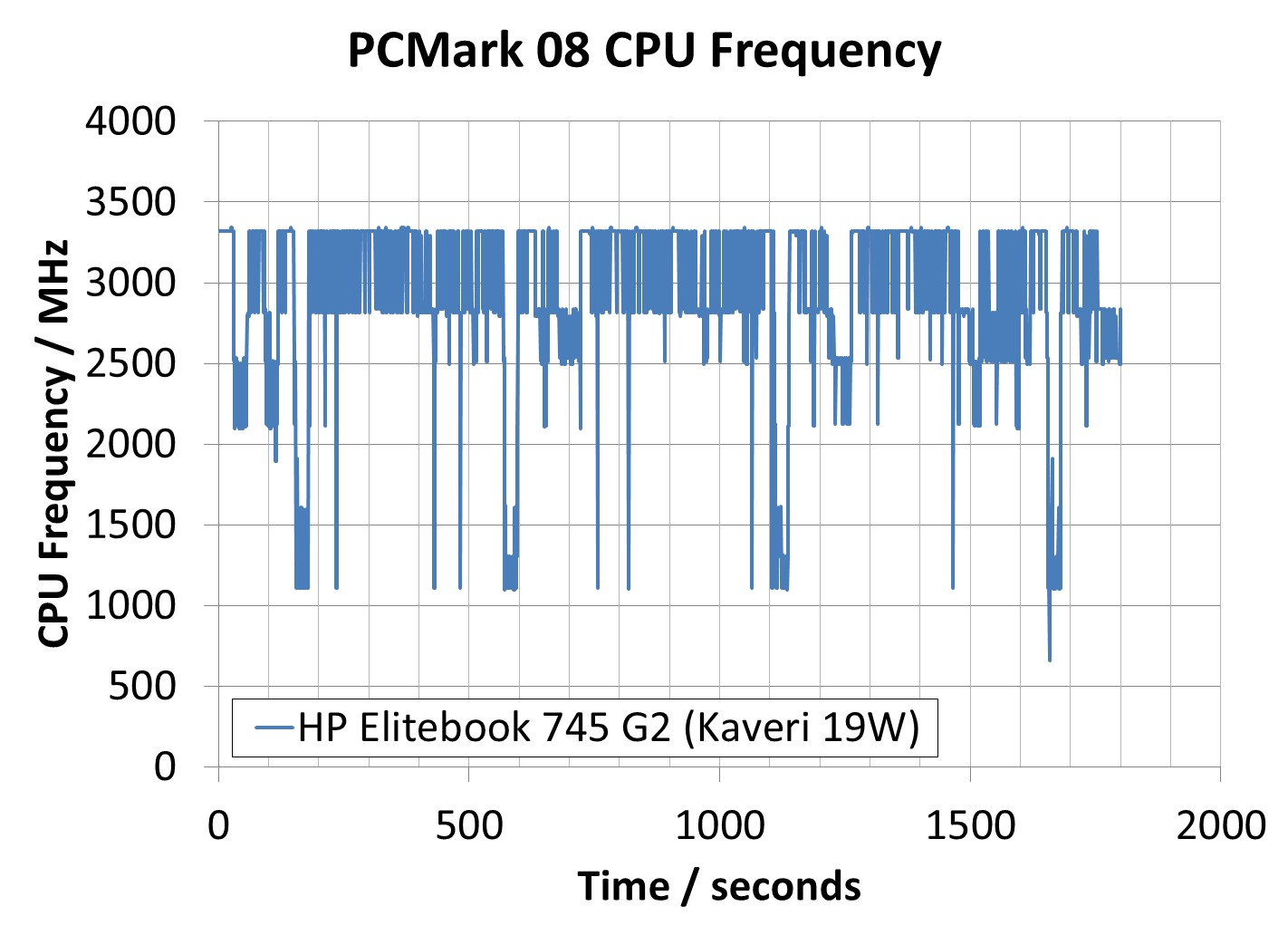

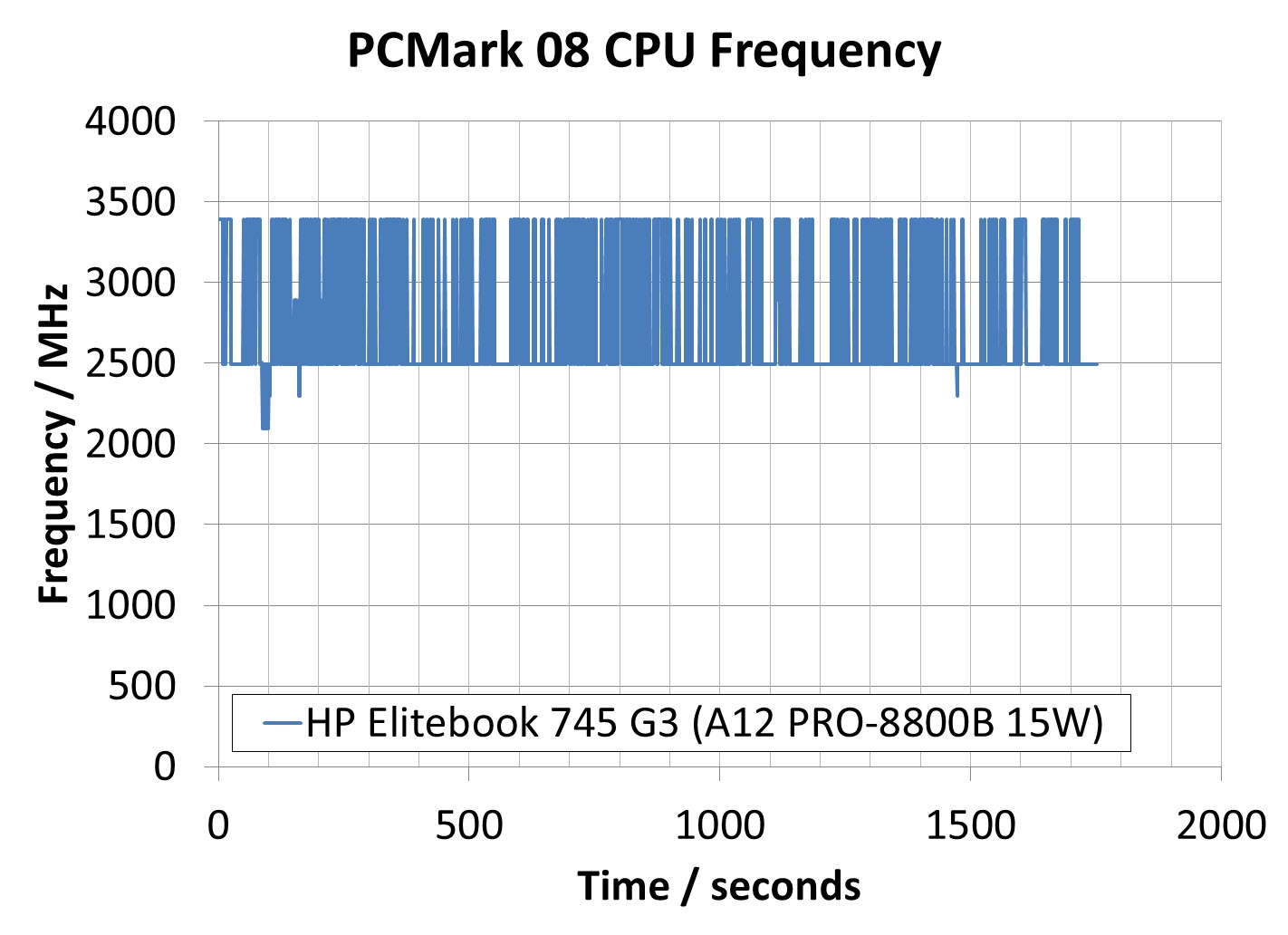
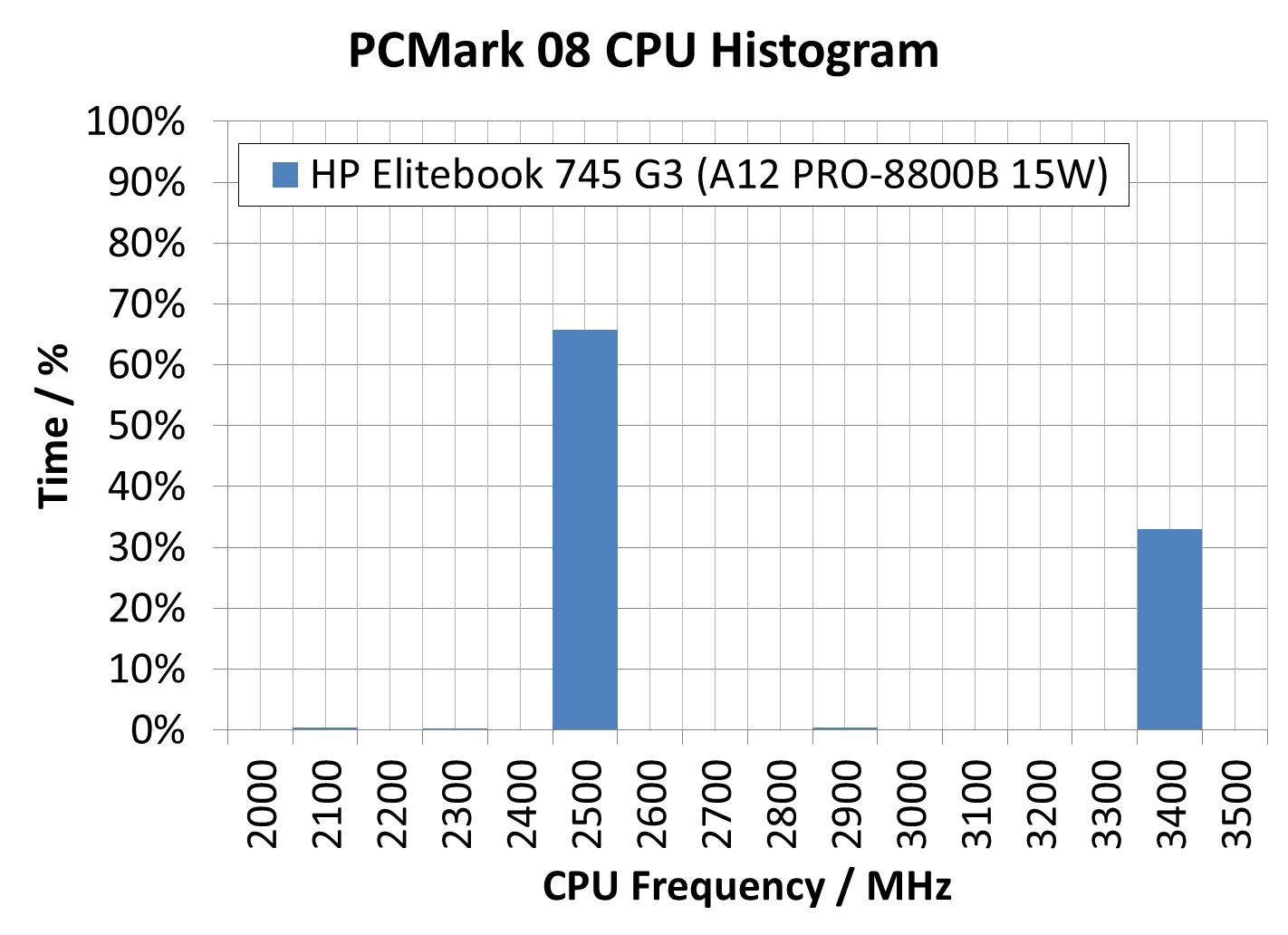

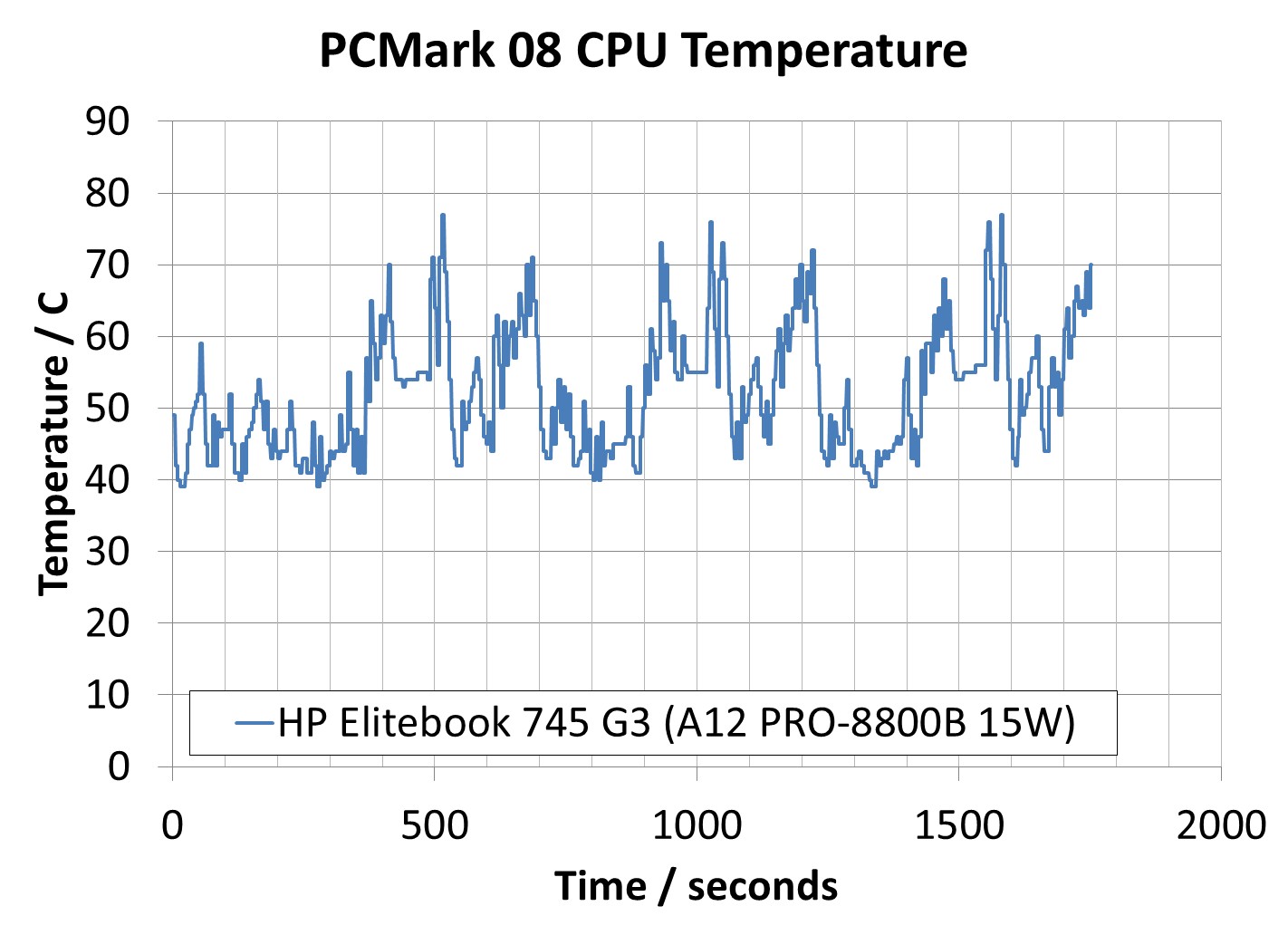










175 Comments
View All Comments
Gadgety - Sunday, February 7, 2016 - link
So AMD's marketing and distribution strategy is a failure. The way it's described it would seem consumers specifying their own PCs would be a away around the dominant logic determined by the existing channels. With today's production technology tailor made products on demand should be possible.The other thing I don't get, is why doesn't AMD release a desktop Carrizo 4K capable APU for the FM2+ platform? Do they want to help the motherboard manufacturers sell more motherboards once the new AM4 socket APU:s are out in 2017, or do they want to sell their own existing products?
JMC2000 - Sunday, February 7, 2016 - link
I think it's more along the lines of having an installed base of AM4 boards before any Zen-based APUs roll out.It is possible that if the Athlon X4 845 sells well, AMD could release a full Carrizo part on FM2+.
AlB80 - Sunday, February 7, 2016 - link
What is discrete graphic chip in Lenovo?512sp GCN1.2.... I suspect that this combination is unreal.
Jamesiii - Sunday, February 7, 2016 - link
I have actually ordered Dell's AMD A8-8600P. It is intended as a media machine with the selling points being the low power equating to quiet and the 4K capability. The one thing I did notice is that he does have the Single Channel DDR3L 1600MHz memory. There is no indication on if it unlocks the watts to 35, but I have my doubts given the choice of RAM.I will know more when I get it on Thursday and will update if anyone is still view this thread. But, at $380.00 it is not a bad choice for a media machine.
tygrus - Sunday, February 7, 2016 - link
OBM (the brands) bid for designs by the ODM's based on the design cost and the expected volume. I high cost Intel design can be made profitable by the expectation of very high volumes. Even the most popular AMD design is expected to sell fewer than a low-volume Intel design. Business limitations and commercial forces bias the system towards Intel. Intel also have deeper pockets to sponsor/partner/subsidise designs to make them Intel exclusive. From manufactures to distributors to retail, Intel penalise (withdraw discounts/subsidies) anyone who lets AMD gain market share (many limited to <10%) and limit the use of the "best" designs for AMD (forced to sell only A4 & A6 instead of A8 or better, limit battery and other features so Intel always looks better). The "Intel brakes" applied to AMD limits their opportunities and potential earnings. This has limited the AMD R&D spending and forced AMD to stay behind in some aspects. It's amazing what AMD has done with 28nm but think of the advantage they could have had with 22nm and 14nm if successful achieved much earlier (no more than 9months after Intel).every1hasaids - Monday, February 8, 2016 - link
I owned (owned being the operative word there) a Y700 with the AMD Carrizo FX8800P and can attest to the fact that the cooling solution and probably several other pieces of that device reviewed in this article are not the same design as what is available on the market in the US. There is a known issue of Lenovo skimping on the VRMs on the AMD Y700 which results in heavy throttling taking place. I couldn't play any game for more than 15 minutes before heavy throttling would occur. The data gathered from the review sample in this article should not be associated with the available product on the market. There appears to also be an FX-8700P variant of the Y700 out there however I cannot find any documentation of the existence of this device on Lenovo's site. Needless to say that I returned that laptop due to the significant throttling problems. I wish this site of some other site could get their hands on one of the FX-8800P Y700 laptops available in the US and put it through testing to reveal the problems with the unit. I'm guessing that they intend on releasing a Carrizo-L version of that laptop with the same motherboard which is why the VRMs are not up to the task of the 35w Carrizo and the added consumption of the dedicated graphics chip.Why are there no units out there that can handle the 35w TDP Carrizo and a dedicated graphics card!?!?!?! It would be a great alternative to the Intel/Nvidia gaming notebook monopoly.
I'm hoping Zen/Polaris will actually see some adoption from OEMs and maybe AMD could even get involved in assisting proper implementation of their products so that the negative stigma could get nullified.
Jamesiii - Monday, February 8, 2016 - link
The FX-8700P would more properly be called an A10-8700P. It sounds like a bit of marketing if they are using the FX handle.On gaming sites people are suggesting you turn off AMD's Turbo Core when gaming to avoid the FPS jumping up and down and overclock the processors. Overclocking a laptop is dicey at best though.
Malih - Monday, February 8, 2016 - link
maybe Microsoft should start making an AMD Surface laptop if they want good competition to drive PC SalesMarcelo Viana - Monday, February 8, 2016 - link
I just don't understand why in a comparison carrizo vs intel you didn't take out the intel chips memory in order to both have 1 channel memory, so do a benchmark for us in a same condition.The entire article show that intel offering has OEMs given what intel chips need, so the point in comparing carrizo vs intel is the chip itself not platform, since AMD has no platform at all.
Elensar286 - Monday, February 8, 2016 - link
That's a large focus of this article, though. The whole point was an investigation in to the implementation of Carrizo APUs by the OEM. It's highlighting exactly how like you said, the OEM platform, is hindering the potential of Carrizo processors.